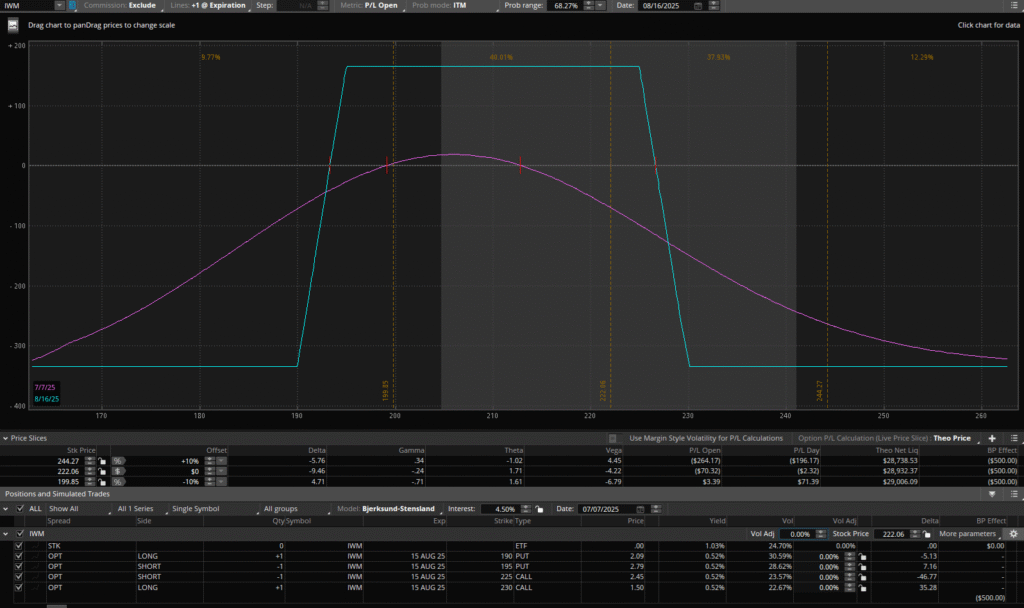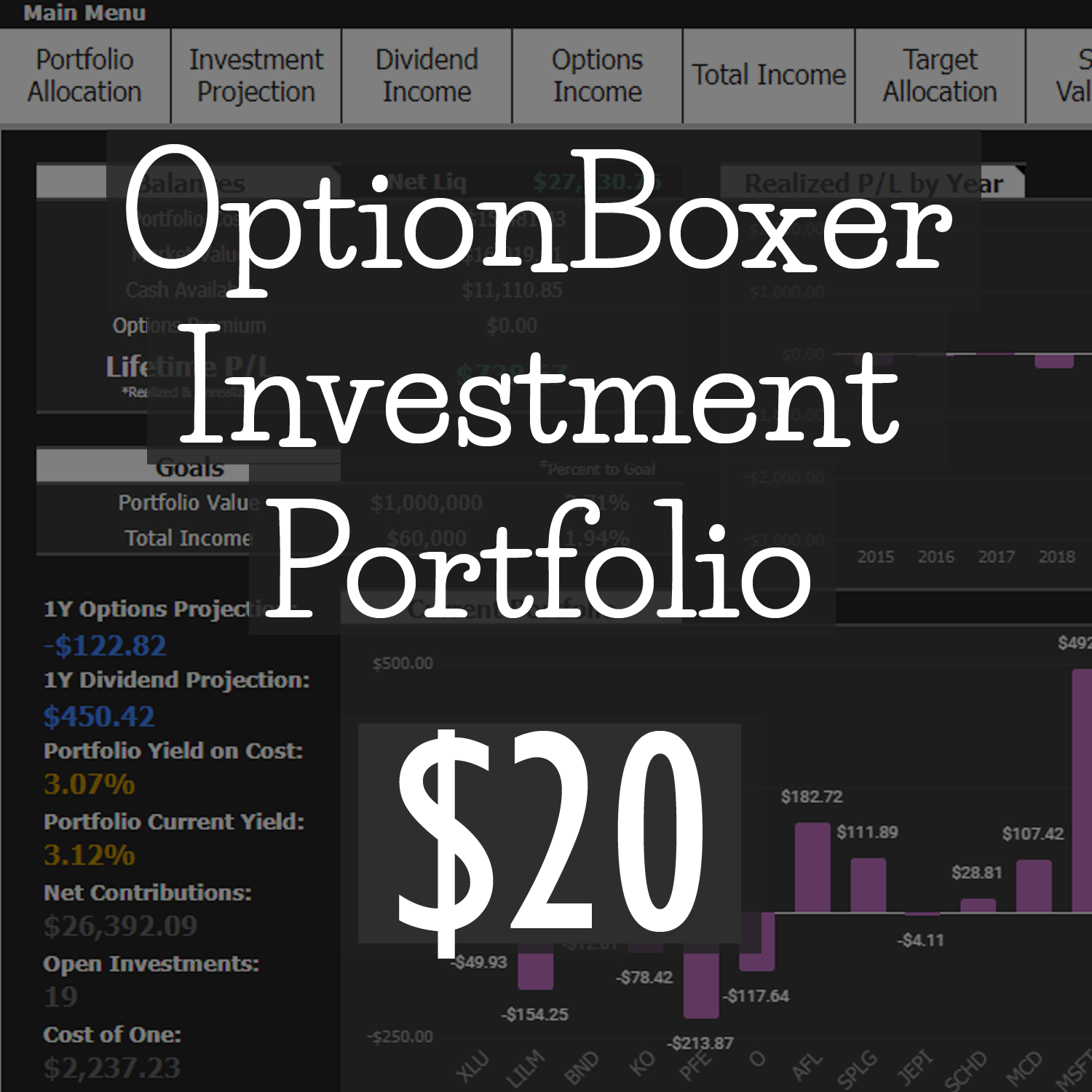Hello again everyone, I hope your 4th of July was spent with family and friends! Today at church we talked about freedom, specifically about our freedom from sin and shame. When Jesus took our place on the cross he delivered us, if we chose, from an eternity of suffering. Instead, His sacrifice made a way for us to join Him in Heaven and I’m so thankful He was willing. As we venture into the back half of 2025 I hope each of us remembers that sacrifice and what He freed us from!
With that, I wanted to talk briefly today about iron condor trade management. I entered an iron condor trade a few weeks ago but as you may know the market has turned bullish. This of course leaves me with a problem to solve as the market races higher. Therefore, in today’s post I wanted to consider the options I have and what steps I’ll take to manage this trade.
Before I do and if you are also an iron condor trader, you may want to have a look at my new Signature Series – Iron Condor Spreadsheet. I truly haven’t found anything as robust or visually attractive as this spreadsheet solely dedicated to the iron condor strategy. If you have any questions please feel free to reach out anytime.
Post Agenda
- Iron Condor Trade Management Overview
- A Misbehaving Iron Condor Trade
- Potential Adjustment Options
- How I’m Adjusting This Trade

Iron Condor Trade Management Overview
First, we need to take a second for those potentially unfamiliar and answer an important question. Why is iron condor trade management important? The simple answer, of course, is to potentially turn a losing trade into a winning trade. However, for those that trade the iron condor options strategy we know it’s a bit more involved than that.
For starters, we have to make another assumption about what the market is going to do next. Clearly, our original assumption of a neutral market was incorrect and is why we’re in this predicament to begin with. So, the reality is, we could be wrong again and only further complicate the problem.
Additionally, the market environment may not currently favor a new iron condor trade. Which is essentially salt on the wound as we try to navigate out of the losing position. To say that another way, it’s like swerving to avoid a wreck only to end up in oncoming traffic. Overly dramatic, I know, but the sentiment is there. We’ve ended up in an undesirable environment.
So, to answer the question, why is iron condor trade management important? Well the hope is, we’re able to avoid collision and arrive safely at our destination. Or, we’re able to steer the trade in a direction that returns us to a profitable conclusion. We don’t know what the market will do next and doing nothing is always a viable option. Still, with options and specifically the iron condor strategy, we have the ability to alter our trade and potentially increase our probability of success.
A Misbehaving Iron Condor Trade
Now, let’s have a look at the trade I’m referencing for this post. I entered into this trade on June 13, 2025 with around 60 days to expiration. As of today, 40 days remain before the contracts expire and volatility has contracted slightly. Lastly, when I entered this trade IWM’s price was just above $210 per share and is currently at $223.08.

As you can see, IWM’s price is pushing into the upper boundary. It hasn’t breached the upside short strike just yet so for now I’m watching and waiting. Still, I want to be ready if I conclude an adjustment is necessary. Ideally, I’d have preferred the decline in volatility to have cushioned my losses a bit more. However, in this instance, implied volatility for the selected contracts expiration hasn’t even declined a full percentage point.
Potential Adjustment Options
Ok, now on to the reason for this post. Iron condor trade management and the myriad of options at my disposal. Rather than elaborate on every adjustment I could make, I’ll just list the adjustments I prefer in bullet format first. That should at least provide some food for thought as you attempt to manage your own iron condor trades. After which, I’ll elaborate on the most likely adjustment options I’ll make to this particular trade.
Iron Condor Adjustment Options
- Make no adjustment
- Roll up the profitable side
- Roll down the unprofitable side
- Roll out the entire trade to a new expiration
- Roll up the profitable side and roll down the unprofitable side
- Buy a call
- Buy a put
- Close the entire trade for a loss
- Close the losing side for a loss
- Close the profitable side for a gain
That list isn’t exhaustive but it does reflect the considerations I typically make for managing my iron condor trades. That said, one option I almost never consider that did stick out to me while typing that list is closing the losing side, temporarily. Potentially locking in the loss for a few days to see if the price move will continue. This would avoid additional losses on the tested side and provide a better entry strike if the trend did continue.
How I’m Adjusting this Trade
With all that having been discussed, in this section I’ll focus in on what I’m likely to do next. Admittedly, it isn’t really a complex problem I’m trying to solve. At this point in my trading journey, I’ve already determined how I’ll move forward if the trade goes against me. If you want to review my iron condor strategy you can see it completely from the iron condor spreadsheet page.
Therefore, I really only need to consider a couple of the options from the previous section. Most of them, for me, only further complicate the situation and lead to additional decisions that I really prefer not to make.
My Adjustment Options
1. Doing nothing is certainly an option. Price could easily move lower from here and stay within the upper boundary. Adjusting the trade would only add commission costs if price did move lower. Not to mention, the losses I’d then be accruing on the currently profitable side of the trade.
2. Roll up the profitable side and roll down the unprofitable side. This is what I’ll ultimately do, the only real question is when. For now, I’m just watching to see what happens. Should volatility spike on the expiration I’m trading I’ll probably move forward with the adjustment just to lock in the new higher level. Iron condors are negative vega and having a higher volatility at entry provides a nice assist if it later contracts.
Final Thoughts
There it is, iron condor trade management, at least as I see it. These days I prefer to keep it simple and not inundate myself with all the possible options. Sure, one of those other options may prove to be the best possible adjustment but there isn’t any way for me to know it today. So, rather than complicate my life managing just one trade, I’ve already decided for all trades, this is what I’ll do.
For those new to the iron condor options strategy, you may consider that as you move forward. You may not extract the entire premium from every trade you’ll ever make but you will avoid the headaches of constant decision making into the unknown.
In conclusion, rolling the entire structure is just the easiest path forward. It recenters the price around the new market price and gives me renewed cushion on either side of the trade. Yes, I’ll have to give up some of the initial credit to accomplish it but keeping price within the short strikes is my preferred approach. I don’t like swerving into oncoming traffic.
Lastly, for those wanting to consider a more advanced adjustment technique, here is a video from Options Trading IQ that discusses such an approach.
Until the next post.
God bless,
Jeff










